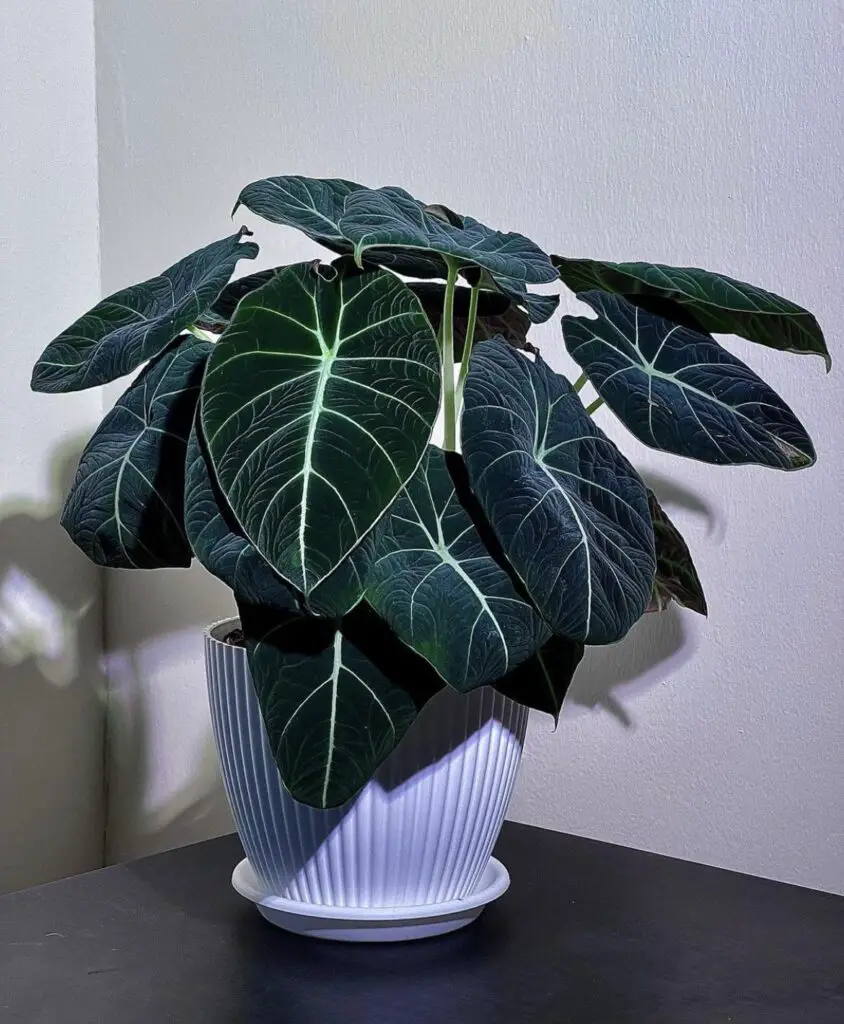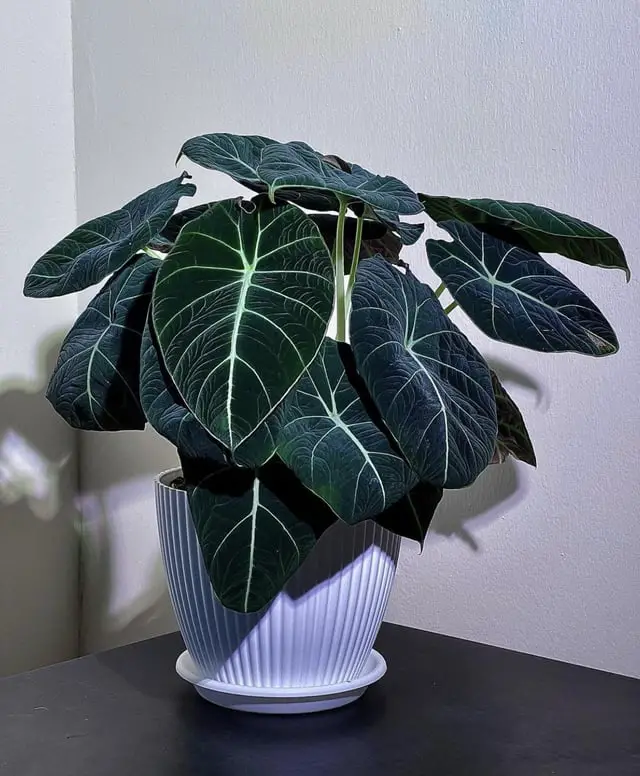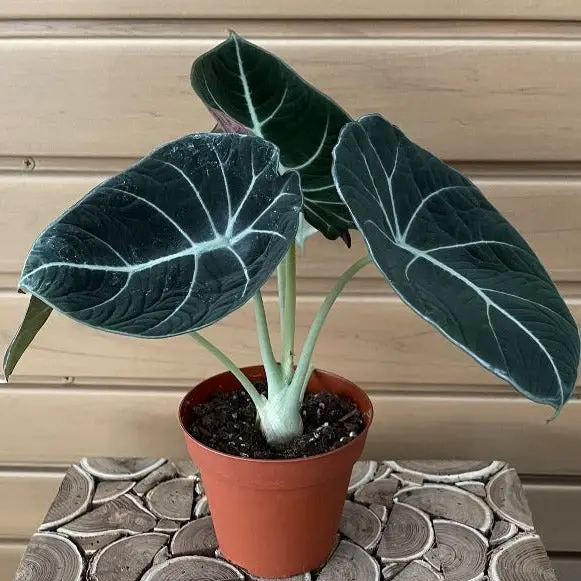The Black Velvet Alocasia Variegated requires bright, indirect light, high humidity, and well-draining soil. Water it when the top inch of soil feels dry. Fertilize during the growing season with a balanced fertilizer. Keep an eye out for pests and repot every couple of years to maintain healthy growth.
Introduction to Black Velvet Alocasia Variegated
The Black Velvet Alocasia Variegated, known for its stunning dark green leaves adorned with striking white veins, has become a favorite among houseplant enthusiasts. This plant is part of the Araceae family and is native to tropical regions. Its unique variegation adds an element of sophistication to any indoor space.

As a member of the Alocasia genus, this plant thrives in environments that mimic its native habitat. This means providing conditions that are both warm and humid. For those who appreciate exotic foliage, the Black Velvet Alocasia Variegated is an excellent choice that can bring life and beauty into your home.
Caring for this plant can be straightforward, provided you pay attention to its specific needs. This section will delve into the essential aspects of caring for your Black Velvet Alocasia Variegated, covering light requirements, watering practices, soil preferences, and more.
Light Requirements
Light plays a crucial role in the health of the Black Velvet Alocasia Variegated. It prefers bright, indirect light but can tolerate lower light conditions as well. However, too much direct sunlight can scorch its delicate leaves.

Here are some tips for providing the right lighting:
- Place the plant near a window that receives filtered light.
- Avoid direct sunlight during peak hours, particularly in summer.
- If natural light is insufficient, consider using grow lights to supplement.
Watering Practices
Watering is another critical factor for the well-being of your Black Velvet Alocasia Variegated. The ideal watering schedule will depend on various conditions such as humidity and temperature. Generally, it’s best to allow the top inch of soil to dry out before watering again.
Consider the following guidelines:

- Check the moisture level by feeling the soil with your finger.
- Water thoroughly until it drains from the bottom of the pot.
- Avoid letting the plant sit in standing water to prevent root rot.
Soil Preferences
The right soil mix is vital for promoting healthy growth in your Black Velvet Alocasia Variegated. This plant thrives in well-draining soil that retains some moisture but does not become soggy. A mix designed for aroids or tropical plants can work wonders.
Consider using a blend that includes:
- Pearlite or pumice for aeration
- Coconut coir or sphagnum moss to retain moisture
- Organic matter such as compost for nutrients
Humidity and Temperature
Humidity levels greatly influence the growth and overall health of the Black Velvet Alocasia Variegated. This plant thrives in high humidity, ideally between 50% to 80%. If you live in a dry climate, you may need to take extra steps to maintain adequate humidity levels.
Here are some methods to boost humidity around your plant:
- Use a humidifier in the room where the plant is located.
- Group plants together to create a microclimate.
- Place a tray of water with pebbles under the pot to increase moisture in the air.
In terms of temperature, this plant prefers warm conditions between 65°F and 80°F (18°C – 27°C). Avoid exposing it to cold drafts or sudden temperature changes.
Fertilizing Your Black Velvet Alocasia Variegated
Fertilization is a key aspect of keeping your Black Velvet Alocasia Variegated healthy and vibrant. During the growing season, which typically runs from spring through summer, your plant will benefit from regular feeding. This helps support new growth and maintain the striking variegation of the leaves.
When choosing a fertilizer, it is important to select one that is balanced and specifically formulated for houseplants. Look for a fertilizer with equal parts of nitrogen, phosphorus, and potassium (N-P-K), such as a 20-20-20 formula. This will ensure your plant receives all the necessary nutrients.
Here are some guidelines for fertilizing:
- Fertilize every 4-6 weeks during the growing season.
- Dilute the fertilizer to half-strength to avoid over-fertilization.
- Avoid fertilizing in fall and winter when the plant’s growth slows down.
Repotting Your Plant
Repotting is essential for keeping your Black Velvet Alocasia Variegated healthy. Over time, the plant may outgrow its pot or the soil may become depleted of nutrients. Repotting allows for fresh soil and more space for root growth.
Generally, your plant should be repotted every 1-2 years. Signs that it is time to repot include:
- Roots growing out of the drainage holes.
- Stunted growth despite proper care.
- Soil that retains too much water or has become compacted.
When repotting, follow these steps:
- Choose a pot that is 1-2 inches larger in diameter than the current one.
- Use fresh, well-draining soil suitable for tropical plants.
- Gently remove the plant from its old pot, taking care not to damage the roots.
- Place the plant in the new pot and fill in around the roots with fresh soil.
- Water thoroughly after repotting to help settle the soil.
Pest Management
Pests can pose a significant threat to the health of your Black Velvet Alocasia Variegated. Common pests include spider mites, aphids, and mealybugs. Early detection and control are crucial to prevent infestations from worsening.
To keep your plant pest-free, consider these practices:
- Regularly inspect the leaves and stems for signs of pests.
- Wipe the leaves with a damp cloth to remove dust and potential pests.
- If you notice pests, isolate the affected plant immediately to prevent spread.
If an infestation occurs, you can use insecticidal soap or neem oil as natural treatments. Apply these products according to the manufacturer’s instructions, ensuring you cover all affected areas of the plant.
Common Problems and Solutions
Even with proper care, your Black Velvet Alocasia Variegated may encounter some common issues. Understanding these problems can help you find effective solutions quickly.
Yellowing Leaves
Yellowing leaves can indicate several issues:
- Overwatering: Ensure that the soil is well-draining and only water when needed.
- Lack of nutrients: Fertilize regularly during the growing season to replenish nutrients.
Wilting Leaves
Wilting leaves may suggest underwatering or low humidity:
- Underwatering: Check the soil moisture and adjust your watering schedule accordingly.
- Low humidity: Increase humidity through methods described previously, such as using a humidifier or pebble trays.
Leaf Spots
If you notice leaf spots, this could be due to fungal infections or water on leaves:
- Avoid overhead watering: Water at the base of the plant to keep leaves dry.
- Improve air circulation: Ensure that your plant has enough space around it to allow for air movement.
By addressing these issues promptly, you can maintain a healthy and beautiful Black Velvet Alocasia Variegated in your home.
Propagation of Black Velvet Alocasia Variegated
Propagation is an exciting way to expand your collection of Black Velvet Alocasia Variegated plants. There are two primary methods for propagating this plant: division and offsets. Both methods can be successful when done correctly, allowing you to create new plants from a healthy parent.
Division Method
Division is the most common way to propagate your Alocasia. This method involves separating the plant into multiple sections, each with its own roots and stems. Here are the steps to follow:
- Choose a mature plant that has several stems.
- Carefully remove the plant from its pot, being cautious not to damage the roots.
- Gently separate the root ball into sections using a clean, sharp knife.
- Ensure each section contains at least one stem and a healthy root system.
- Repot each section into a new, well-draining soil mix.
- Water thoroughly and place in a warm, humid environment.
Offset Method
Offsets are small plants that grow from the base of the parent plant. They can be removed and planted separately. Here’s how to propagate using offsets:
- Identify healthy offsets that have developed roots.
- Gently twist or cut the offset away from the parent plant.
- Make sure it has some roots attached.
- Plant the offset in a small pot with a well-draining soil mix.
- Water lightly and place in a location with bright, indirect light.
Choosing the Right Pot
The choice of pot is crucial for the health of your Black Velvet Alocasia Variegated. An appropriate pot will provide enough space for root growth and ensure proper drainage. Here are some factors to consider when selecting a pot:
- Size: Select a pot that is 1-2 inches larger in diameter than the current pot. Avoid pots that are too large, as they can retain excess moisture.
- Material: Clay pots are excellent for moisture regulation because they allow for airflow. Plastic pots are lighter but may retain more moisture.
- Drainage holes: Ensure that the pot has drainage holes to prevent water from accumulating at the bottom, which can lead to root rot.
Seasonal Care Adjustments
Car
ing for your Black Velvet Alocasia Variegated may vary with the seasons. Adjusting your care routine according to seasonal changes can help maintain optimal growth and health.
Spring and Summer
During spring and summer, your plant is in its active growth phase. Here are some care tips:
- Increase watering frequency as the plant absorbs more moisture.
- Fertilize every 4-6 weeks to support new growth.
- Monitor humidity levels closely and maintain high humidity if possible.
Fall and Winter
In fall and winter, growth slows down significantly. Adjust your care as follows:
- Reduce watering frequency, allowing the top inch of soil to dry out between waterings.
- Avoid fertilizing during this period as the plant is not actively growing.
- Keep humidity levels stable but do not overwater, as this can lead to root rot.
Common Myths About Black Velvet Alocasia Variegated
There are several myths surrounding the care of Black Velvet Alocasia Variegated. Knowing these misconceptions can help prevent mistakes in its care.
Myth 1: They Can Survive in Low Light Conditions
This plant thrives in bright, indirect light. While it can tolerate lower light levels, it will not grow optimally and may lose its vibrant color.
Myth 2: More Water Is Always Better
Overwatering is one of the leading causes of plant stress. It is essential to let the soil dry out slightly between waterings to prevent root rot.
Myth 3: They Are Toxic Only to Pets
The Black Velvet Alocasia Variegated is toxic not only to pets but also to humans if ingested. Exercise caution when placing this plant in homes with small children or animals.
Understanding these aspects of care and propagation will help you enjoy a thriving Black Velvet Alocasia Variegated. With proper attention, this stunning plant can become a centerpiece in your indoor garden.
Caring for Your Black Velvet Alocasia Variegated: Additional Tips
In
addition to the care guidelines discussed, there are a few more tips that can enhance the health and aesthetics of your Black Velvet Alocasia Variegated. These practices can help create an optimal environment for your plant’s growth and ensure it remains a stunning feature in your home.
Regular Cleaning
Keeping the leaves of your Black Velvet Alocasia Variegated clean is essential for its overall health. Dust can accumulate on the leaves, obstructing light absorption and leading to potential pest issues. Here are some cleaning tips:
- Wipe leaves gently with a damp cloth or sponge to remove dust.
- Use lukewarm water to avoid shocking the plant.
- Avoid using chemical leaf shine products, as they can block pores and harm the plant.
Seasonal Adjustments
As seasons change, so do the needs of your Black Velvet Alocasia Variegated. Pay attention to the following seasonal adjustments:
- In spring, you may notice new growth. This is the time to increase watering and fertilization to support this growth.
- During summer, monitor for signs of heat stress, such as wilting or browning edges, and adjust your watering routine accordingly.
- In fall, prepare your plant for dormancy by reducing watering and halting fertilization.
- In winter, maintain a stable temperature and humidity level to help the plant through the cooler months.
Choosing Companions
If you plan to keep multiple plants together, consider choosing companions that share similar care requirements. Plants that thrive in high humidity and bright, indirect light make excellent partners for your Black Velvet Alocasia Variegated. Some compatible plants include:
- Pothos
- Ferns
- Peace Lilies
- Philodendrons
Grouping plants together can also help create a microclimate with increased humidity, which benefits all plants involved.
Final Thoughts
Caring for a Black Velvet Alocasia Variegated is an enriching experience that rewards you with stunning foliage and a touch of tropical elegance. Understanding its specific needs—such as appropriate lighting, watering schedules, humidity levels, and potting requirements—will ensure your plant thrives.
Remember that patience is key. This plant may take time to adjust to new environments or potting situations. By providing consistent care and monitoring for any issues, you can enjoy the beauty of this exotic plant for many years.
Furthermore, staying informed about common myths can help you avoid pitfalls in care. As you cultivate your understanding of the Black Velvet Alocasia Variegated’s needs, you will become more adept at fostering a healthy living environment for this beautiful plant.
With proper attention and care, the Black Velvet Alocasia Variegated can become a centerpiece in your home, showcasing its striking beauty while enhancing your indoor space. Enjoy nurturing this remarkable plant and watching it flourish!
